Banana: Diseases and Symptoms
Banana: Diseases and Symptoms
Panama wilt
Disease symptoms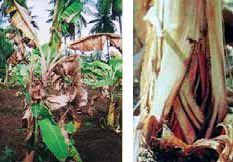 Yellowing of the lower most leaves starting from margin to midrib of the leaves
Yellowing of the lower most leaves starting from margin to midrib of the leaves- Yellowing extends upwards and finally heart leaf alone remains green for some time and it is also affected.
- The leaves break near the base and hang down around pseudostem.
- Longitudinal splitting of pseudostem. Discolouration of vascular vessels as red or brown streaks.
- The pathogen spreads through infected rhizomes
- Continuous cultivation in the infested field or monocroping results in buildup of inoculum
Mycosphaerella leaf spot, yellow sigatoka, black sigatoka
Disease symptoms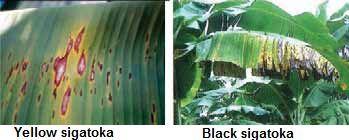 Early symptoms appear on the third or fourth leaf from the top, i.e., on young leaves.
Early symptoms appear on the third or fourth leaf from the top, i.e., on young leaves.- Small spindle shaped spots on foliage with greyish centre and yellowish halo running parallel to veins.
- If the fruit is nearing maturity at the time of heavy infection, the flesh ripens but evenly and individual bananas appear undersized and their flesh develops a buff pinkish colour, and store poorly.
- The conidia of the fungus are carried by wind ,rain water and old dried infected leaves and they help to spread the disease
Anthracnose
Disease symptoms At the initial stage, small, circular, black spots develop on the affected fruits. Then these spots enlarge in size, turn to brown colour
At the initial stage, small, circular, black spots develop on the affected fruits. Then these spots enlarge in size, turn to brown colour- The skin of the fruit turns black and shrivels and becomes covered with characteristic pink acervuli. Finally the whole finger is affected. Later the disease spreads and affects the whole bunch.
- The disease results in premature ripening and shriveling of the fruits which are covered with pink spore masses.
- Occurrence if black lesions on the pedicel causes withering of the pedicel and dropping of the fingers from the hands
- Sometimes the main stalk of the bunch may become diseased. Infected fruits become black and rotten
- The spread of the disease is by air-borne conidia and numerous insects which frequently visit banana flowers also spread the disease
- The disease is favoured by high atmospheric temperature and humidity, wounds and brusies caused in the fruit and susceptibility of the variety
Moko disease/bacterial wilt
Disease symptoms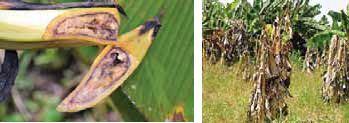 Leaves become yellow and progress upwards. The petiole breaks and leaves hang.
Leaves become yellow and progress upwards. The petiole breaks and leaves hang.- When it is cut open discolouration in vascular region with pale yellow to dark brown colour.
- The discolouration is in the central portion of the corm.
- Internal rot of fruits with dark brown discoloration.
- When the pseudostem is cut transversely bacterial ooze can be seen.
- The bacterium survives in infected plant material, vegetative propagative organs, wild host plants, and soil.
- High temperatures and high soil moisture generally favors disease
Tip over or bacterial soft rot
Disease symptoms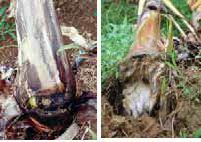 This disease is more pronounced on young suckers leading to rotting and emitting of foul odour
This disease is more pronounced on young suckers leading to rotting and emitting of foul odour- Roting of collar region is a commonest symptom followed by epinasty of leaves, which dry out suddenly
- If affected plants are pulled out it comes out from the collar region leaving the corm with their roots in the soil
- In early stage of infection dark brown or yellow water soaked areas are more in the cortex area When affected plants are cut open at collar region yellowish to reddish ooze is seen.
- Bacteria survive in crop debris and infect by water splash through damaged tissues.
- Worse in hot wet weather. The bacteria spread in contaminated water.
- Higher temperatures and high humidity are ideal growing conditions for the bacteria
Bunchy top/curly top
Disease symptoms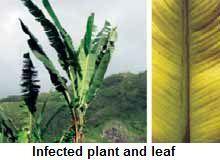 Prominent dark green streaks on the petioles and midrib along the leaf veins.
Prominent dark green streaks on the petioles and midrib along the leaf veins.- Marginal chlorosis and curling of leaves
- Petioles fail to elongate
- Leaves are reduced in size, chlorotic, stand upright and become brittle and are crowded at the top (Bunchy top) and shoe dark green streaks with ‘J hook’ shape near the midrib.
- Flowers display mottled and streaked discolouration
- Plants show marked stunting
- Vector: banana aphid, Pentalonia nigronervosa
- The disease can be spread by infected plant debris, plant wounds and injuries.
- Hot and damp weather with plenty of rainfall trigger the disease to occur.
Banana bract mosaic virus (BBMV)
Disease symptoms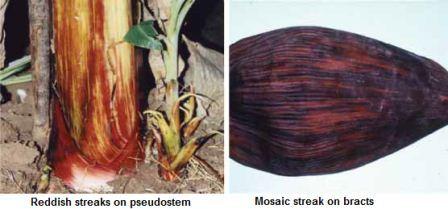 The disease is characterized by the presence of spindle shaped pinkish to reddish streaks on pseudostem, midrib and peduncle
The disease is characterized by the presence of spindle shaped pinkish to reddish streaks on pseudostem, midrib and peduncle- Typical mosaic and spindle shaped mild mosaic streaks on bracts, peduncle and fingers also observed
- Suckers exhibit unusual reddish brown streaks at emergence and separation of leaf sheath from central axis
- Clustering of leaves at crown with a travelers palm appearance, elongated peduncle and half filled hands are its characteristic symptom.
- The disease is caused by a virus belonging to potyvirus group. The virions are flexuous filamentous
- The virus is transmitted through aphid vectors such as Aphis gosypii, Pentolonia nigronervosa and Rhopalosiphum maidis. In field the disease spread mainly through suckers
Banana streak disease (BSV)
Disease symptoms- A prominent symptom exhibited by BSV is yellow streaking of the leaves, which becomes progressively necrotic producing a black streaked appearance in older leaves.
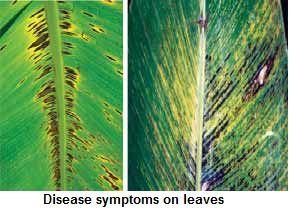 The virus is transmitted mostly through infected planting materials, though mealy bugs (Planococcus citri) and more probably Saccharicoccus sacchari are also believed to transmit it. Shoot tip culture does not eliminate it from vegetatively propagated materials.
The virus is transmitted mostly through infected planting materials, though mealy bugs (Planococcus citri) and more probably Saccharicoccus sacchari are also believed to transmit it. Shoot tip culture does not eliminate it from vegetatively propagated materials.
Infectious chlorosis (CMV)
Disease symptoms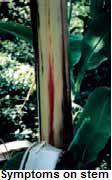 The disease manifests itself in all stages of crop growth.
The disease manifests itself in all stages of crop growth.- Due to repeated use of suckers from infected plants the disease spreads and resulting in the gradual decrease in yield and quality.
- The disease is known to occur in all banana-growing states.
- Light yellow streaks run parallel to leaf veins giving the leaf a striped appearance.
- The streaks run usually from mid rib to edge of the blade.
- Virus is disseminated by suckers and Aphis gossypi.
IPM for Banana
To know the IPM practices for Banana, click here.
Source: NIPHM and Directorate of Plant Protection, Quarantine & Storage
Last Modified : 2/29/2020
© C–DAC.All content appearing on the vikaspedia portal is through collaborative effort of vikaspedia and its partners.We encourage you to use and share the content in a respectful and fair manner. Please leave all source links intact and adhere to applicable copyright and intellectual property guidelines and laws.
RELATED ITEMS
Horsegram Diseases
This topic covers information about Horsegram Dise...
Fig Diseases
This topic covers information about Fig Diseases.
Custard Apple Diseases
This topic covers the information related to disea...
Clusterbean
This topic explains about Improved Cultivation Pra...
